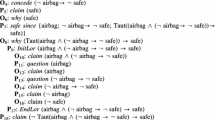Abstract
In this paper, we study dialogue as a game, but not only in the sense in which there would exist winning strategies and a priori rules. Dialogue is not governed by game rules like for chess or other games, since even if we start from a priori rules, it is always possible to play with them, provided that some invariant properties are preserved. An important discovery of Ludics is that such properties may be expressed in geometrical terms. The main feature of a dialogue is “convergence”. Intuitively, a dialogue “diverges” when it stops prematurely by some disruption, or a violation of the tacit agreed upon conditions of the discourse. It converges when the two speakers go together towards a situation where they agree at least on some points. As we shall see, convergence may be thought of through the geometrical concept of orthogonality. Utterances in a dialogue have as their content, not only the processes (similar to proofs) which lead to them from a monologic view, but also their interactions with other utterances. Finally, any utterance must be seen as co-constructed in an interaction between two processes. That is to say that it not only contains one speaker’s intentions but also his or her expectations from the other interlocutor. From our viewpoint, discursive strategies like narration, elaboration, topicalization may derive from such interactions, as well as speech acts like assertion, question and denegation.
Similar content being viewed by others
References
Andréoli J.-M. (1992) Logic programming with focusing proofs in linear logic. The Journal of Logic and Computation 2(3): 297–347
Asher N., Lascarides A. (1998) Questions in dialogue. Linguistics and Philosophy 21: 237–309
Asher N., Lascarides A. (2003) Logics of conversation. Cambridge University Press, Cambridge
Basaldella, M., & Faggian, C. (2009). Ludics with repetitions (exponentials, interactive types and completeness). In 24th IEEE Symposium on Logic in Computer Science (LICS 2009).
Beyssade, C., & Marandin, J.-M. (2006). The speech act assignment problem revisited. In CSSP proceedings, http://www.cssp.cnrs.fr.
Brandom R. (2000) Articulating reasons. An introduction to Inferentialism. Harvard University Press, Cambridge, MA
Changeux J.-P (2004) L’homme de vérité, ed. Odile Jacob, Paris
Curien, P.-L. (2006). Introduction to linear logic and ludics, part I and II. Advances in Mathematics (China) 34(5), 513–544 (2005) and 35(1), 1–44.
Ducrot O. (1984) Le dire et le dit. Editions de Minuit, Paris
Faggian, C. (2002). On the dynamics of Ludics. A study of Interaction, PhD thesis. Université d’Aix-Marseille II.
Ginzburg, J., & Fernandez, R. (2009). Computational Models of Dialogue. In A. Clark, C. Fox, & S. Lappin (Eds.), Computational linguistics and natural language processing handbook.
Girard J.-Y. (1987) Linear logic. Theoretical Computer Science 50: 1–102
Girard J.-Y. (1999) On the meaning of logical rules-I. In: Berger U., Schwichtenberg H. (eds) Computational logic. Springer, Heidelberg
Girard J.-Y. (2001) Locus solum. Mathematical Structures in Computer Science 11: 301–506
Girard J.-Y. (2003) From foundations to Ludics. Bulletin of Symbolic Logic 09: 131–168
Girard J.-Y. (2006) Le Point Aveugle. Hermann, Paris
Groenendijk, J. (2009). Inquisitive Semantics: questions, assertions and hybrids. Amsterdam, http://www.illc.uva.nl/inquisitive-semantics.
Groenendijk, J., & Roelofsen, R. (2010). Compliance. In A. Lecomte & S. Tronçon (Eds.) Ludics, Dialogue and Interaction. Springer Folli, LNAI 6505.
Grosz B., Sidner C. (1986) Attentions, intentions and the structure of discourse. Computational Linguistics 12: 175–204
Lecomte, A., & Quatrini, M. (2009). Ludics and its applications to natural language semantics. In H. Ono, M. Kanazawa, & R. de Queiroz (Eds.), Proceedings 16th International Workshop, WoLLIC 2009. Tokyo, Springer-Folli LNAI 5514.
Lecomte, A., & Quatrini, M. (2010). Pour une étude du langage via l’interaction: dialogues et sémantique en Ludique. Mathématique et Sciences Humaines, 189.
Lorenz, K. (1961). Arithmetik und Logik als Spiele, PhD thesis. Universität Kiel.
Lorenzen, P. (1978). Logik und Agon. In Atti del XII Congresso Internazionale di Filosofia, Venezia, 1958, reprinted in Lorenzen and Lorenz Dialogische Logik, Wissenschaftliche Buchgesellschaft.
Martin-Löf P. (1984) Intuitionistic type theory. Bibliopolis, Naples
Pietarinen A.-V. (2007) Game theory and linguistic meaning. Elsevier, Amsterdam
Ranta A. (1994) Type-theoretical grammar. Oxford University Press, Oxford
Sundholm G. (1986) Proof theory and meaning. In: Gabbay D., Guenthner F. (eds) Handbook of philosophical logic (Vol. III. D. Reidel, Dordrecht, pp 471–506
Van Kuppevelt J. (1996) Directionality in discourse: Prominence differences in subordination relations. Journal of Semantics 13(4): 363–395
Walton D. (2000) The place of dialogue theory in logic, computer science and communication studies. Synthese 123: 327–346
Wittgenstein L. (1953) Philosophische Untersuchungen. Blackwell, London
Author information
Authors and Affiliations
Corresponding author
Rights and permissions
About this article
Cite this article
Lecomte, A., Quatrini, M. Figures of dialogue: a view from Ludics. Synthese 183 (Suppl 1), 59–85 (2011). https://doi.org/10.1007/s11229-011-0014-6
Received:
Accepted:
Published:
Issue Date:
DOI: https://doi.org/10.1007/s11229-011-0014-6




